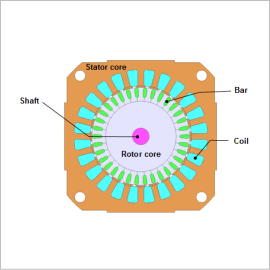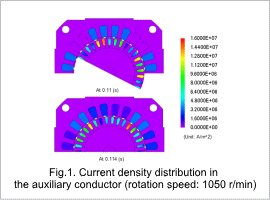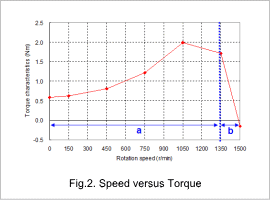*Please prepare a license ID and password for the license administrator.
*It is different from the service for JMAG WEB MEMBER (free membership). Please be careful.
Overview

An induction motor is a motor in which the rotating magnetic field of the stator coils causes induced current to flow in an auxiliary conductor, exerting force on the rotor in the rotational direction and causing it to spin. Induction motors are widely used in everything from industrial machines to home appliances because they have a simple construction and are small, light, affordable, and maintenance-free.
In an induction motor, the current induced by the auxiliary conductor exerts a large influence on its characteristics. It also causes strong magnetic saturation in the vicinity of the gap, in particular. With Finite Element Analysis (FEA), it is possible to investigate the characteristics that accurately evaluate the features listed above, so preliminary design evaluations are effective.
This Application Note introduces a case example of how to obtain the current density distribution of an auxiliary conductor and its rotation speed versus torque characteristics.
In an induction motor, the current induced by the auxiliary conductor exerts a large influence on its characteristics. It also causes strong magnetic saturation in the vicinity of the gap, in particular. With Finite Element Analysis (FEA), it is possible to investigate the characteristics that accurately evaluate the features listed above, so preliminary design evaluations are effective.
This Application Note introduces a case example of how to obtain the current density distribution of an auxiliary conductor and its rotation speed versus torque characteristics.
Current Density Distribution

The current density distribution at a rotation speed of 1050 r/min is shown in fig. 1. The torque in an induction motor is generated between the rotational flux stemming from the current flowing in the stator coil and the current induced in the auxiliary conductor, so the induced current has a large influence on the torque characteristics.
Speed-Torque Curve

The Speed-Torque curve is shown in fig. 2. The maximum torque is found to be near 1000 r/min. Based on the fact that the torque in the high speed region gets higher, it can also be seen that the auxiliary conductor’s electric resistance in this induction motor is low. In the range labeled b in fig. 2, the speed change is only about 5%, with a 100% change in the torque, so the motor is rotating in a stable fashion.


